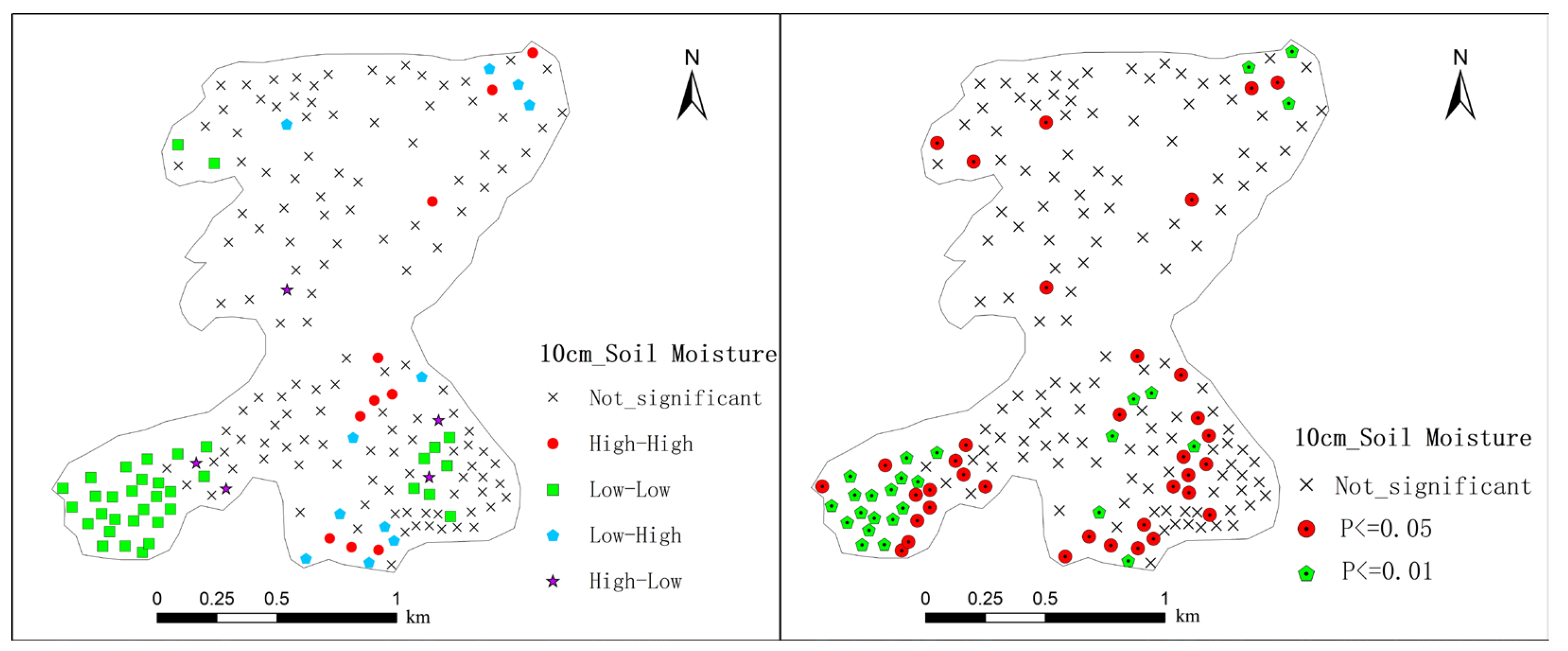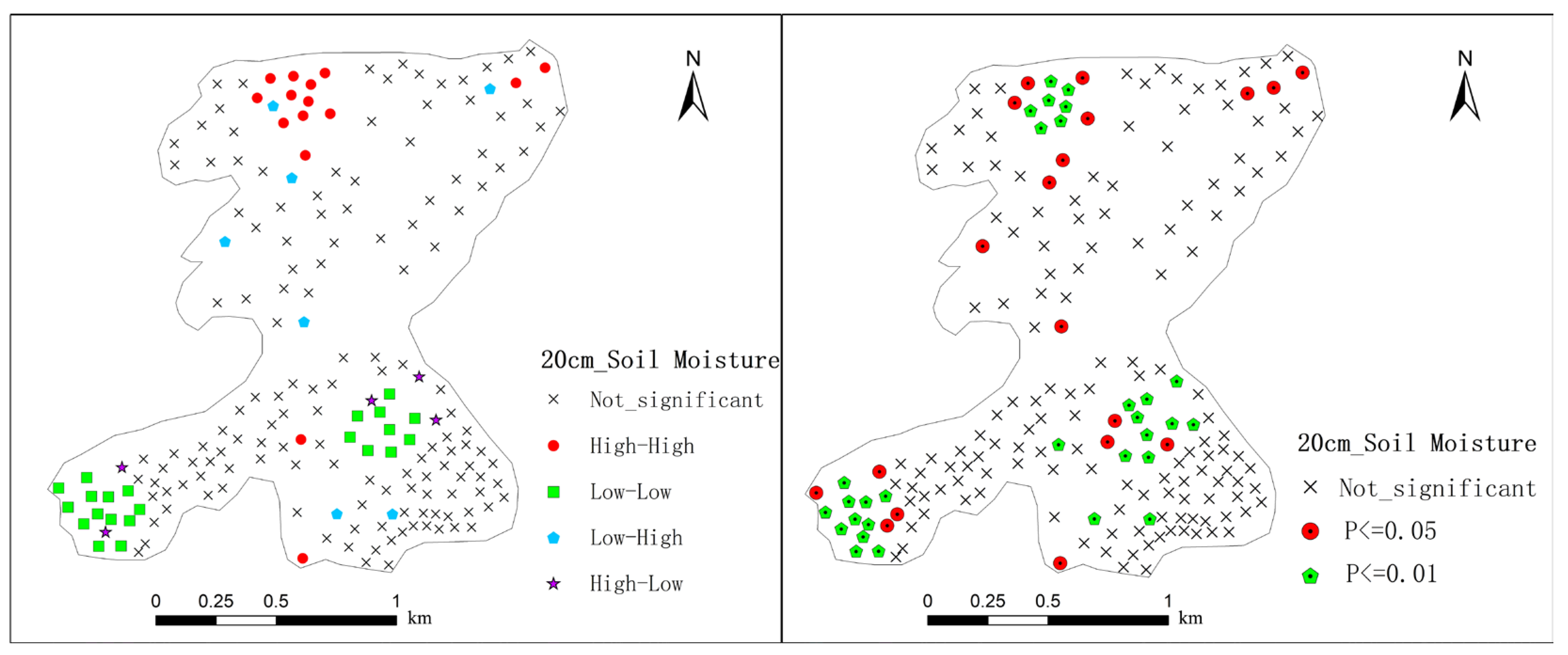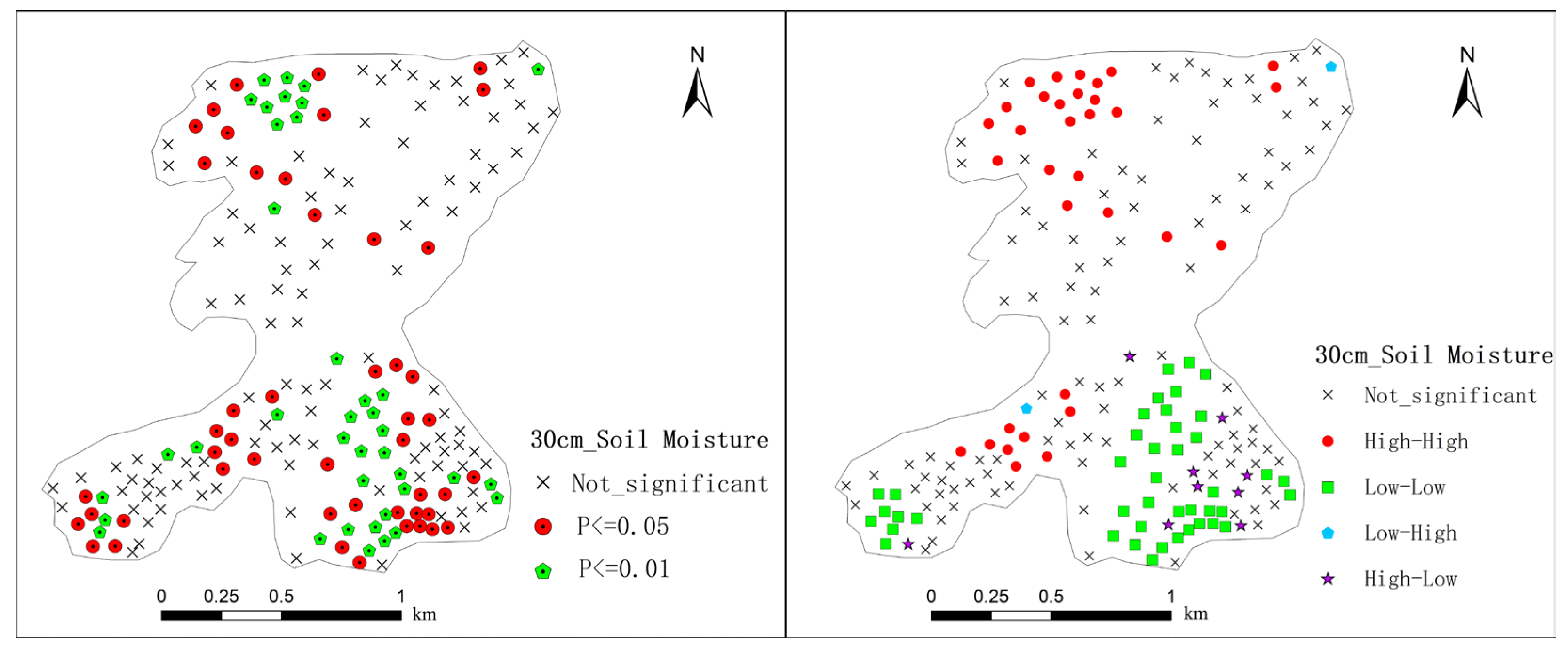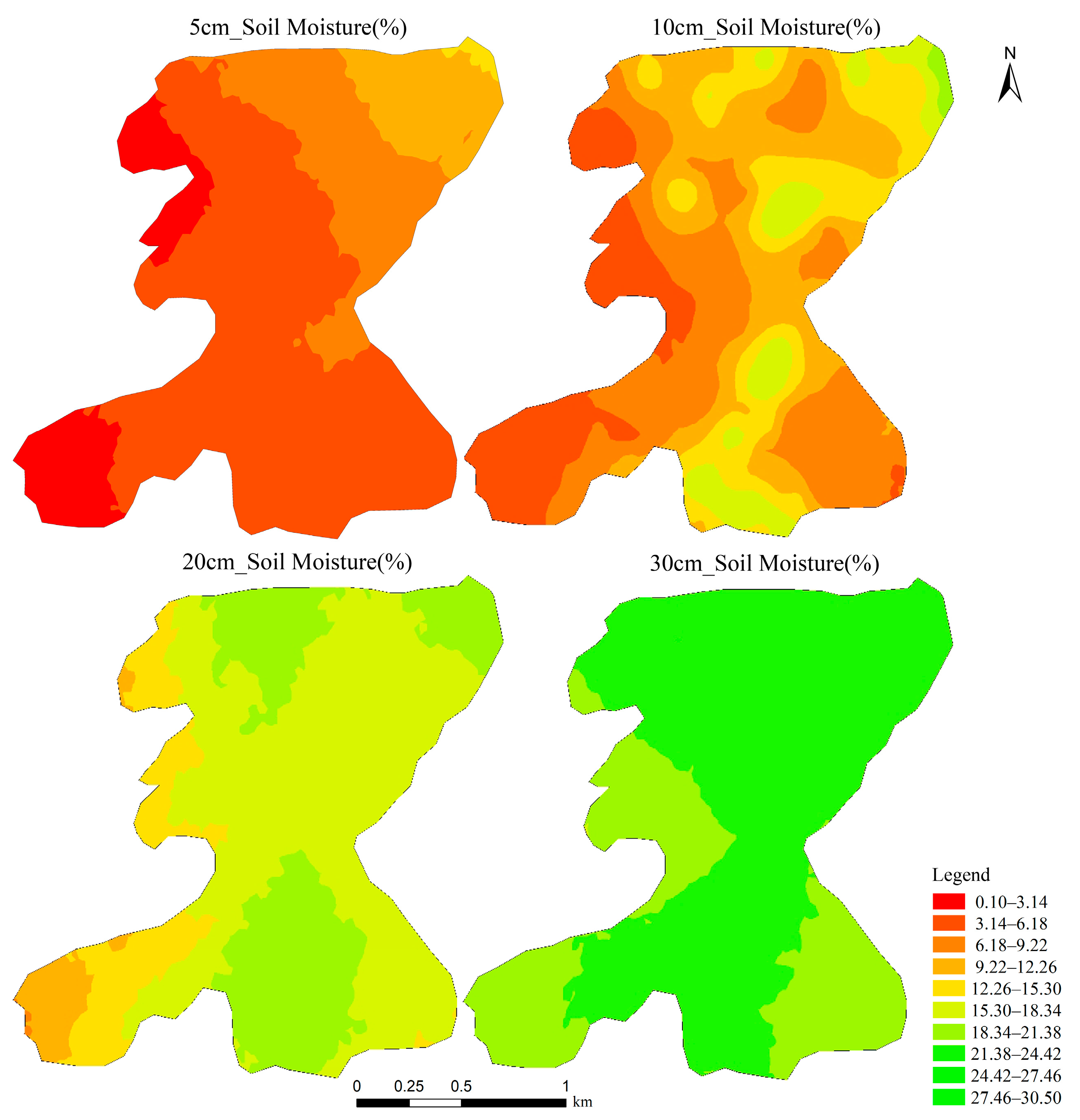Spatial Structure and Optimal Sampling Intervals of Soil Moisture at Different Depths in a Typical Karst Demonstration Zone
Abstract
1. Introduction
2. Materials and Methods
2.1. Site Description
2.2. Experimental Design and Field Sampling
2.3. Statistical Analysis
2.4. Spatial Autocorrelation Analysis
2.5. Semivariogram Analysis and Kriging Interpolation
3. Results
3.1. Descriptive Statistical Analysis Results
3.2. The Spatial Structure of Soil Moisture
3.2.1. The Global Spatial Autocorrelation of Soil Moisture
3.2.2. The Local Spatial Autocorrelation Analysis of Soil Moisture
3.2.3. The Semivariogram Model Analysis of Soil Moisture
3.2.4. Spatial Distribution of Soil Moisture
3.3. Main Controlling Factors of the Spatial Variations in Soil Moisture
- (a)
- The transition from non-rock desertification to mild rock desertification showed that as rock desertification occurred and progressed, vegetation cover and soil depth tended to decrease, and the water-holding capacity of vegetation and soil tended to decline, leading to an overall decrease in soil moisture; However, with the emergence of moderate or severe rock desertification, values of soil moisture at different soil depths were generally higher than those at other levels of rock desertification. In areas with moderate or severe rock desertification, soil depth distribution was uneven. Therefore, in areas with less soil, soil typically accumulated in small depressions, erosion pits, and caves, where it possessed greater water storage capacity and lower evaporation rates.
- (b)
- Soil moisture values varied significantly at different soil depths, primarily due to the impact of vegetation cover on soil water storage capacity. Therefore, in areas with vegetation cover of more than 20%, soil moisture values increased with increasing values of vegetation coverage, and presented distinct layering characteristics as soil depth changed. However, in areas with vegetation coverage of 0–20%, soil moisture was relatively high because these soil moisture sampling points were primarily located near villages where residents pumped the groundwater for irrigation, resulting in surface spring water overflow phenomena.
- (c)
- Soil moisture values increased with soil depth because soil moisture at the soil surface was prone to evaporation and downward penetration. In contrast, deeper soil layers had relatively stronger water-holding capacity. Since soil moisture evaporation primarily occurred at the soil surface, the average evaporation rate of soil moisture tended to decrease with increasing soil depth, making it easier for soil moisture to be retained in the soil.
- (d)
- Elevation had a particular influence on soil moisture, as water—particularly soil moisture in soils at higher elevations—tended to flow toward lower-lying areas of slopes via surface runoff or subsurface runoff due to gravitational forces. This process accumulated water in the soils of low-lying areas.
4. Discussion
5. Conclusions
Author Contributions
Funding
Data Availability Statement
Conflicts of Interest
Abbreviations
| 3S | GIS, RS, and GPS |
| GIS | Geography information systems |
| RS | Remote sensing |
| GPS | Global positioning systems |
References
- Humphrey, V.; Berg, A.; Ciais, P.; Gentine, P.; Jung, M.; Reichstein, M.; Seneviratne, S.I.; Frankenberg, C. Soil Moisture–Atmosphere Feedback Dominates Land Carbon Uptake Variability. Nature 2021, 592, 65–69. [Google Scholar] [CrossRef]
- Li, J.; Niu, Z.; Guo, Z.; Li, J.; Ye, S.; Hua, D. Improving Soil Water Dynamics and Crop Productivity through Conservation Tillage in Arid Regions. Sci. Rep. 2025, 15, 25242. [Google Scholar] [CrossRef]
- Niu, N.; Fan, J.; Yang, Z. The Spatial and Temporal Variations Evaluation of Water Conservation in Guizhou Province Based on InVEST Model. Sci. Rep. 2025, 15, 22413. [Google Scholar] [CrossRef]
- Radolinski, J.; Vremec, M.; Wachter, H.; Birk, S.; Brüggemann, N.; Herndl, M.; Kahmen, A.; Nelson, D.B.; Kübert, A.; Schaumberger, A.; et al. Drought in a Warmer, CO2-Rich Climate Restricts Grassland Water Use and Soil Water Mixing. Science 2025, 387, 290–296. [Google Scholar] [CrossRef] [PubMed]
- Zhang, J.; Ren, F.; Zhang, R.; Ding, L.; Li, F.; Li, X.; Zhong, T.; Yin, M.; Du, L.; Yang, R.; et al. Effects of Crushed Wheat Straw with Plastic Film Mulch on Soil Hydrothermal Properties and Water Use Efficiency of Sunflower in the Northwestern Arid Region of China. Sci. Rep. 2025, 15, 23066. [Google Scholar] [CrossRef]
- Heydari, L.; Bayat, H.; Sarmadian, F. Spatial Relationships between the van Genuchten Soil-Water Retention Curve Parameters and Photosynthetic Gas Exchange Variables in a Wheat Field. Soil Tillage Res. 2023, 234, 105850. [Google Scholar] [CrossRef]
- Yu, J.; Zheng, W.; Xu, L.; Meng, F.; Li, J.; Zhangzhong, L. TPE-CatBoost: An Adaptive Model for Soil Moisture Spatial Estimation in the Main Maize-Producing Areas of China with Multiple Environment Covariates. J. Hydrol. 2022, 613, 128465. [Google Scholar] [CrossRef]
- Wu, F.; Guo, S.; Huang, W.; Han, Y.; Wang, Z.; Feng, L.; Wang, G.; Li, X.; Lei, Y.; Zhi, X.; et al. Soil Water Movement May Regulate Soil Water Consumption and Improve Cotton Yields under Different Cotton Cropping Systems. Ind. Crops Prod. 2024, 211, 118278. [Google Scholar] [CrossRef]
- Xin, M.; Wu, F.; Wang, G.; Li, X.-F.; Li, Y.; Han, Y.; Yang, B.; Dong, H.; Guo, S.; Feng, L. Water Dynamics and Competition in Cotton Populations: Assessing Soil Moisture Utilization and Yield Patterns under Different Planting Densities Using Advanced Spatial Monitoring and Analysis. Ind. Crops Prod. 2025, 224, 120333. [Google Scholar] [CrossRef]
- Orouskhani, E.; Sahoo, S.R.; Agyeman, B.T.; Bo, S.; Liu, J. Impact of Sensor Placement in Soil Water Estimation. IFAC Pap. 2022, 55, 340–345. [Google Scholar] [CrossRef]
- Gélinas, M.; Jutras, S. Gamma Radiation for the Estimation of Mineral Soil Water Content in a Boreal Forest. Can. J. Soil Sci. 2024, 104, 191–203. [Google Scholar] [CrossRef]
- Zhang, M.; Zhang, D.; Jin, Y.; Wan, X.; Ge, Y. Evolution of Soil Moisture Mapping from Statistical Models to Integrated Mechanistic and Geoscience-Aware Approaches. Inf. Geogr. 2025, 1, 100005. [Google Scholar] [CrossRef]
- Dash, S.K.; Sinha, R. Space-Time Dynamics of Soil Moisture and Groundwater in an Agriculture-Dominated Critical Zone Observatory (CZO) in the Ganga Basin, India. Sci. Total Environ. 2022, 851, 158231. [Google Scholar] [CrossRef]
- Luo, P.; Song, Y.; Huang, X.; Ma, H.; Liu, J.; Yao, Y.; Meng, L. Identifying Determinants of Spatio-Temporal Disparities in Soil Moisture of the Northern Hemisphere Using a Geographically Optimal Zones-Based Heterogeneity Model. ISPRS J. Photogramm. Remote Sens. 2022, 185, 111–128. [Google Scholar] [CrossRef]
- Hodges, B.; Tagert, M.L.; Paz, J.O.; Meng, Q. Assessing In-Field Soil Moisture Variability in the Active Root Zone Using Granular Matrix Sensors. Agric. Water Manag. 2023, 282, 108268. [Google Scholar] [CrossRef]
- Lin, S.; Wei, K.; Wang, Q.; Deng, M.; Su, L.; Shao, F.; Jiang, Z. Spatiotemporal Variability of Soil Physical Properties and Water, Salt, Nitrogen, and Phosphorus Contents for Farm Level. Can. J. Soil Sci. 2023, 103, 406–427. [Google Scholar] [CrossRef]
- Molenaar, R.E.; Kleidorfer, M.; Kohl, B.; Teuling, A.J.; Achleitner, S. Does Afforestation Increase Soil Water Buffering? A Demonstrator Study on Soil Moisture Variability in the Alpine Geroldsbach Catchment, Austria. J. Hydrol. 2024, 643, 131984. [Google Scholar] [CrossRef]
- Zhang, Z.; Yin, H.; Chang, J.; Xue, J. Spatial Variability of Surface Soil Water Content and Its Influencing Factors on Shady and Sunny Slopes of an Alpine Meadow on the Qinghai–Tibetan Plateau. Glob. Ecol. Conserv. 2022, 34, e02035. [Google Scholar] [CrossRef]
- Li, J.; Ren, J.; Fan, X.; Zhou, P.; Pu, Y.; Zhang, F. Estimation of Unfrozen Water Content in Frozen Soils Based on Data Interpolation and Constrained Monotonic Neural Network. Cold Reg. Sci. Technol. 2024, 218, 104094. [Google Scholar] [CrossRef]
- Owens, P.R.; Mancini, M.; Winzeler, E.H.; Read, Q.; Sun, N.; Blackstock, J.; Libohova, Z. Simulating Water Dynamics Related to Pedogenesis across Space and Time: Implications for Four-Dimensional Digital Soil Mapping. Geoderma 2024, 447, 116911. [Google Scholar] [CrossRef]
- Alkassem, M.; Buis, S.; Coulouma, G.; Jacob, F.; Lagacherie, P.; Prévot, L. Estimating Soil Available Water Capacity within a Mediterranean Vineyard Watershed Using Satellite Imagery and Crop Model Inversion. Geoderma 2022, 425, 116081. [Google Scholar] [CrossRef]
- Zhang, L.; Liu, Y.; Ren, L.; Teuling, A.J.; Zhang, X.; Jiang, S.; Yang, X.; Wei, L.; Zhong, F.; Zheng, L. Reconstruction of ESA CCI Satellite-Derived Soil Moisture Using an Artificial Neural Network Technology. Sci. Total Environ. 2021, 782, 146602. [Google Scholar] [CrossRef]
- Tang, F.; Ma, T.; Tang, J.; Yang, Q.; Xue, J.; Zhu, C.; Wang, C. Space-Time Dynamics and Potential Drivers of Soil Moisture and Soil Nutrients Variation in a Coal Mining Area of Semi-Arid, China. Ecol. Indic. 2023, 157, 111242. [Google Scholar] [CrossRef]
- Rawat, K.S.; Sehgal, V.K.; Singh, S.K.; Ray, S.S. Soil Moisture Estimation Using Triangular Method at Higher Resolution from MODIS Products. Phys. Chem. Earth Parts ABC 2022, 126, 103051. [Google Scholar] [CrossRef]
- Xu, M.; Yao, N.; Yang, H.; Xu, J.; Hu, A.; de Goncalves, L.G.G.; Liu, G. Downscaling SMAP Soil Moisture Using a Wide & Deep Learning Method over the Continental United States. J. Hydrol. 2022, 609, 127784. [Google Scholar] [CrossRef]
- Xu, M.; Yang, H.; Hu, A.; Heng, L.; Li, L.; Yao, N.; Liu, G. A Deep Learning Approach for SMAP Soil Moisture Downscaling Informed by Thermal Inertia Theory. Int. J. Appl. Earth Obs. Geoinf. 2025, 136, 104370. [Google Scholar] [CrossRef]
- Zhao, H.; Li, J.; Yuan, Q.; Lin, L.; Yue, L.; Xu, H. Downscaling of Soil Moisture Products Using Deep Learning: Comparison and Analysis on Tibetan Plateau. J. Hydrol. 2022, 607, 127570. [Google Scholar] [CrossRef]
- Zheng, M.; Liu, Z.; Li, J.; Xu, Z.; Sun, J. Downscaling Soil Moisture in Regions with High Soil Heterogeneity: The Solution Based on Ensemble Learning with Sequential and Parallel Learner. Sci. Total Environ. 2024, 950, 175260. [Google Scholar] [CrossRef]
- Zhu, Z.; Bo, Y.; Sun, T.; Zhang, X.; Sun, M.; Shen, A.; Zhang, Y.; Tang, J.; Cao, M.; Wang, C. A Downscaling-and-Fusion Framework for Generating Spatio-Temporally Complete and Fine Resolution Remotely Sensed Surface Soil Moisture. Agric. For. Meteorol. 2024, 352, 110044. [Google Scholar] [CrossRef]
- Koujani, S.R.; Hosseini, S.A.; Sharafati, A. Soil Moisture Downscaling in the State of Oklahoma: Employing Advanced Machine Learning. J. Atmos. Sol. Terr. Phys. 2025, 268, 106454. [Google Scholar] [CrossRef]
- Zhang, M.; Ge, Y.; Ma, Y.; Jin, Y.; Chen, Y.; Liu, S. Downscaling Multilayer Soil Moisture Using Parameterized Depth Profiles Associated with Environmental Factors. J. Hydrol. 2025, 661, 133544. [Google Scholar] [CrossRef]
- Tunçay, T.; Alaboz, P.; Dengiz, O.; Başkan, O. Application of Regression Kriging and Machine Learning Methods to Estimate Soil Moisture Constants in a Semi-Arid Terrestrial Area. Comput. Electron. Agric. 2023, 212, 108118. [Google Scholar] [CrossRef]
- Zhang, M.; Ge, Y.; Heuvelink, G.B.M.; Ma, Y. High Resolution Soil Moisture Mapping in 3D Space and Time Using Machine Learning and Depth Functions. Geoderma 2024, 452, 117117. [Google Scholar] [CrossRef]
- Anand, A.; Singh, P.; Srivastava, P.K.; Gupta, M. Chapter 19—GIS-Based Analysis for Soil Moisture Estimation via Kriging with External Drift. In Agricultural Water Management; Srivastava, P.K., Gupta, M., Tsakiris, G., Quinn, N.W., Eds.; Academic Press: Cambridge, MA, USA, 2021; pp. 391–408. ISBN 978-0-12-812362-1. [Google Scholar]
- Campos Mantovanelli, B.; Petry, M.T.; Broetto Weiler, E.; Carlesso, R. Geostatistical Interpolation Based Ternary Diagrams for Estimating Water Retention Properties in Soils in the Center-South Regions of Brazil. Soil Tillage Res. 2021, 209, 104973. [Google Scholar] [CrossRef]
- Yan, P.; Lin, K.; Wang, Y.; Zheng, Y.; Gao, X.; Tu, X.; Bai, C. Spatial Interpolation of Red Bed Soil Moisture in Nanxiong Basin, South China. J. Contam. Hydrol. 2021, 242, 103860. [Google Scholar] [CrossRef]
- Gao, Y.; Yang, P. Temporal and Spatial Distribution of Soil Water Repellency in Grassland Soils and Its Relation to Soil Moisture, Hydrophobic Matter, and Particle Size. Sci. Total Environ. 2023, 904, 166700. [Google Scholar] [CrossRef]
- Anjum, M.; Siddique, N.; Younis, H.; Faiz, Y.; Shafique, M.A.; Mahnoor, A.; Sajid, A.; Altaf, M. Heavy Metals and Radionuclides in Islamabad’s Industrial Area: A Comprehensive Analysis of Soil and Water Pollution, Source Apportionment and Health Effects Using Statistical and Geospatial Tools. J. Trace Elem. Miner. 2024, 8, 100127. [Google Scholar] [CrossRef]
- Pérez-de-los-Reyes, C.; Sánchez-Ormeño, M.; Bravo Martín-Consuegra, S.; García-Pradas, J.; Pérez-de-los-Reyes, M.L.; Ramírez, A.; Ortíz-Villajos, J.Á.A.; García Navarro, F.J.; Jiménez-Ballesta, R. The Influence of Depth on the Water Retention Properties of Vineyard Soils. Agric. Water Manag. 2022, 261, 107384. [Google Scholar] [CrossRef]
- Jin, J.; Zhang, B.; Mao, X. Improved Stratified Sampling Strategy for Estimating Mean Soil Moisture Based on Auxiliary Variable Spatial Autocorrelation. Soil Tillage Res. 2022, 215, 105212. [Google Scholar] [CrossRef]
- Hasanova, S.A. Construction of a Diagnostic Algorithm for Soil Identification According to the International Soil Classification System Wrb. Adv. Inf. Syst. 2024, 8, 100–106. [Google Scholar] [CrossRef]
- Shi, X.Z.; Yu, D.S.; Xu, S.X.; Warner, E.D.; Wang, H.J.; Sun, W.X.; Zhao, Y.C.; Gong, Z.T. Cross-Reference for Relating Genetic Soil Classification of China with WRB at Different Scales. Geoderma 2010, 155, 344–350. [Google Scholar] [CrossRef]
- Shao, S.; Zhang, H.; Fan, M.; Su, B.; Wu, J.; Zhang, M.; Yang, L.; Gao, C. Spatial Variability-Based Sample Size Allocation for Stratified Sampling. CATENA 2021, 206, 105509. [Google Scholar] [CrossRef]
- Dong, S.; Chen, Z.; Gao, B.; Guo, H.; Sun, D.; Pan, Y. Stratified Even Sampling Method for Accuracy Assessment of Land Use/Land Cover Classification: A Case Study of Beijing, China. Int. J. Remote Sens. 2020, 41, 6427–6443. [Google Scholar] [CrossRef]
- Li, G.; Rubinato, M.; Wan, L.; Wu, B.; Luo, J.; Fang, J.; Zhou, J. Preliminary Characterization of Underground Hydrological Processes under Multiple Rainfall Conditions and Rocky Desertification Degrees in Karst Regions of Southwest China. Water 2020, 12, 594. [Google Scholar] [CrossRef]
- Yang, Q.; Zhang, F.; Jiang, Z.; Li, W.; Zhang, J.; Zeng, F.; Li, H. Relationship between Soil Depth and Terrain Attributes in Karst Region in Southwest China. J. Soils Sediments 2014, 14, 1568–1576. [Google Scholar] [CrossRef]
- Qi-yong, Y.; Zhong-cheng, J.; Wen-jun, L.; Hui, L. Prediction of Soil Organic Matter in Peak-Cluster Depression Region Using Kriging and Terrain Indices. Soil Tillage Res. 2014, 144, 126–132. [Google Scholar] [CrossRef]
- Bu, R.; Han, S.; Cheng, W.; Wu, Y.; Tang, S.; Li, M.; Wang, H.; Ge, Z.; Wu, J. Deciphering the Role of Particulate Organic Matter in Soil Nitrogen Transformation in Rice–Rapeseed and Rice–Wheat Rotation Systems. Appl. Soil Ecol. 2024, 193, 105146. [Google Scholar] [CrossRef]
- Zhang, R.; Xie, Y.; Xue, T.; Liu, S.; Tian, F.; Ji, X.; Pan, S. Quantify the Environmental Factors Interaction Affecting Soil Cd/as Accumulation in Farmland Using Collaborative Filtering Model Combining Global Spatial and Local Property Graph. Environ. Geochem. Health 2025, 47, 376. [Google Scholar] [CrossRef] [PubMed]
- Zhang, C.; Lei, S.; Wu, H.; Liao, L.; Wang, X.; Zhang, L.; Liu, G.; Wang, G.; Fang, L.; Song, Z. Simplified Microbial Network Reduced Microbial Structure Stability and Soil Functionality in Alpine Grassland along a Natural Aridity Gradient. Soil Biol. Biochem. 2024, 191, 109366. [Google Scholar] [CrossRef]
- Li, H.; Tang, B.; Lehmann, A.; Rongstock, R.; Zhu, Y.; Rillig, M.C. The Dissimilarity between Multiple Management Practices Drives the Impact on Soil Properties and Functions. Soil Ecol. Lett. 2025, 7, 240278. [Google Scholar] [CrossRef]
- Abdullah, B.; Niazi, M.B.K.; Jahan, Z.; Shah, T.; Malik, U.S.; Beig, B.; Mahmood, A.; Shah, G.A.; Iqbal, Z. Zinc-Coated Urea with Gelatin-Enhanced Zinc Biofortification, Apparent Nitrogen Recovery, and Ryegrass Production. J. Soil Sci. Plant Nutr. 2024, 24, 1460–1473. [Google Scholar] [CrossRef]
- Teng, T.; Chen, Y.; Wang, Y.; Qiao, X. In Situ Nuclear Magnetic Resonance Observation of Pore Fractures and Permeability Evolution in Rock and Coal under Triaxial Compression. J. Energy Eng. 2025, 151, 04025036. [Google Scholar] [CrossRef]
- Cao, Z.; Zhang, S.; Du, F.; Ma, D.; Li, Z.; Huang, C.; Wang, W. Water Inrush Mechanism and Variable Mass Seepage of Karst Collapse Columns Based on a Nonlinear Coupling Mechanical Model. Mine Water Environ. 2025, 44, 259–274. [Google Scholar] [CrossRef]
- Tong, C.; Ye, Y.; Zhao, T.; Bao, H.; Wang, H. Soil Moisture Disaggregation via Coupling Geographically Weighted Regression and Radiative Transfer Model. J. Hydrol. 2024, 634, 131053. [Google Scholar] [CrossRef]
- Qu, Y.; Zhu, Z.; Montzka, C.; Chai, L.; Liu, S.; Ge, Y.; Liu, J.; Lu, Z.; He, X.; Zheng, J.; et al. Inter-Comparison of Several Soil Moisture Downscaling Methods over the Qinghai-Tibet Plateau, China. J. Hydrol. 2021, 592, 125616. [Google Scholar] [CrossRef]
- Shangguan, Y.; Tong, C.; Shi, Z.; Wang, H.; Deng, X. Comparison of Different Downscaling Schemes for Obtaining Regional High-Resolution Soil Moisture Data. Int. J. Appl. Earth Obs. Geoinf. 2025, 141, 104652. [Google Scholar] [CrossRef]
- Wang, J.; Li, X.; Zhang, Z.; Li, X.; Han, Y.; Feng, L.; Yang, B.; Wang, G.; Lei, Y.; Xiong, S.; et al. Application of Image Technology to Simulate Optimal Frequency of Automatic Collection of Volumetric Soil Water Content Data. Agric. Water Manag. 2022, 269, 107674. [Google Scholar] [CrossRef]









| Soil Depth (cm) | Minimum (%) | Maximum (%) | Mean (%) | Variance Coefficient | Standard Deviation | Kurtosis | Skewness |
|---|---|---|---|---|---|---|---|
| 5 | 0.10 | 23.40 | 5.10 | 67.73 | 3.45 | 4.17 | 1.52 |
| 10 | 0.60 | 29.10 | 9.62 | 65.76 | 6.33 | 1.35 | 1.47 |
| 20 | 2.70 | 31.10 | 16.87 | 35.75 | 6.03 | −0.60 | −0.06 |
| 30 | 6.90 | 30.00 | 22.06 | 18.30 | 4.04 | 2.69 | −1.39 |
| Soil Depth (cm) | Model | Determining Coefficient (R2) | Nugget (C0) | Sill (C0 + C) | Nugget/Sill Ratio (%) | Range (m) |
|---|---|---|---|---|---|---|
| 5 | Gaussian | 0.90 | 0.46 | 1.78 | 25.84 | 3701.39 |
| 10 | Spherical | 0.91 | 0.20 | 0.41 | 48.78 | 776.00 |
| 20 | Exponential | 0.79 | 0.14 | 0.28 | 50.00 | 6318.00 |
| 30 | Spherical | 0.74 | 0.02 | 0.06 | 33.33 | 646.00 |
| Soil Depth (cm) | Upper Carboniferous (C3) | Lower Permian (P1q) |
|---|---|---|
| 5 | 4.12 | 5.87 |
| 10 | 8.84 | 10.05 |
| 20 | 16.36 | 17.28 |
| 30 | 22.76 | 21.49 |
| Soil Depth (cm) | 176.4–260.5 (m) | 260.5–327.7 (m) | 327.7–379.5 (m) | 379.5–432.8 (m) | 432.8–535.0 (m) |
|---|---|---|---|---|---|
| 5 | 8.13 | 5.13 | 4.52 | 4.20 | 4.52 |
| 10 | 13.48 | 7.66 | 8.58 | 6.43 | 10.29 |
| 20 | 19.55 | 15.66 | 16.20 | 16.88 | 14.69 |
| 30 | 23.13 | 21.96 | 21.75 | 21.84 | 20.79 |
| Soil Depth (cm) | 0–10 (°) | 10–20 (°) | 20–30 (°) | 30–40 (°) | >40 (°) |
|---|---|---|---|---|---|
| 5 | 6.03 | 4.75 | 5.39 | 5.23 | 3.70 |
| 10 | 10.86 | 8.82 | 10.81 | 8.79 | 8.46 |
| 20 | 17.37 | 14.80 | 16.39 | 13.34 | 12.52 |
| 30 | 21.78 | 22.43 | 21.61 | 22.55 | 20.33 |
| Soil Depth (cm) | 0–15 (cm) | 15–30 (cm) | 30–45 (cm) | >45 (cm) |
|---|---|---|---|---|
| 5 | 4.62 | 4.27 | 5.03 | 6.84 |
| 10 | 14.79 | 10.20 | 7.96 | 11.17 |
| 20 | — | 17.73 | 15.09 | 19.45 |
| 30 | — | — | 21.38 | 22.96 |
| Soil Depth (cm) | 0–20 (%) | 20–40 (%) | 40–60 (%) | 60–80 (%) | 80–100 (%) |
|---|---|---|---|---|---|
| 5 | 5.80 | 4.50 | 4.67 | 5.69 | 5.70 |
| 10 | 15.70 | 9.84 | 8.37 | 10.96 | 9.73 |
| 20 | 22.60 | 17.56 | 15.98 | 17.61 | 23.10 |
| 30 | — | 20.61 | 22.02 | 22.28 | 25.80 |
| Soil Depth (cm) | No Rocky Desertification | Mild Rocky Desertification | Moderate Rocky Desertification | Fierce Rocky Desertification |
|---|---|---|---|---|
| 5 | 5.43 | 4.60 | 4.39 | 10.80 |
| 10 | 10.01 | 8.44 | 10.09 | 15.85 |
| 20 | 17.03 | 16.05 | 17.48 | 20.60 |
| 30 | 21.85 | 21.65 | 23.11 | 21.20 |
| Soil Depth (cm) | Geological Background | Altitude (m) | Slope (°) | Soil Thickness (cm) | Vegetation Coverage (%) | Rocky Desertification |
|---|---|---|---|---|---|---|
| 5 | 1.531 | 2.616 | 0.754 | 1.306 | 0.613 | 9.182 |
| 10 | 0.732 | 7.474 | 1.401 | 8.090 | 7.984 | 10.615 |
| 20 | 0.423 | 3.368 | 4.107 | 4.823 | 10.553 | 3.866 |
| 30 | 0.806 | 0.694 | 0.785 | 1.248 | 4.872 | 0.669 |
| Mean | 0.873 | 3.538 | 1.762 | 3.867 | 6.006 | 6.083 |
| Rank | 6 | 4 | 5 | 3 | 2 | 1 |
| Soil Depth (cm) | Geological Background | Altitude (m) | Slope (°) | Soil Thickness (cm) | Vegetation Coverage (%) | Rocky Desertification |
|---|---|---|---|---|---|---|
| Geological background | 0.762 | 3.089 | 1.538 | 3.376 | 5.243 | 5.310 |
| Altitude (m) | 12.517 | 6.234 | 13.681 | 21.249 | 21.522 | |
| Slope (°) | 3.105 | 6.814 | 10.583 | 10.718 | ||
| Soil thickness (cm) | 14.954 | 23.225 | 23.523 | |||
| Vegetation coverage (%) | 36.072 | 36.534 | ||||
| Rocky desertification | 37.003 |
Disclaimer/Publisher’s Note: The statements, opinions and data contained in all publications are solely those of the individual author(s) and contributor(s) and not of MDPI and/or the editor(s). MDPI and/or the editor(s) disclaim responsibility for any injury to people or property resulting from any ideas, methods, instructions or products referred to in the content. |
© 2025 by the authors. Licensee MDPI, Basel, Switzerland. This article is an open access article distributed under the terms and conditions of the Creative Commons Attribution (CC BY) license (https://creativecommons.org/licenses/by/4.0/).
Share and Cite
Yin, H.; Xiong, B.; Lao, X.; Jiang, Z.; Wu, Y.; Wang, T. Spatial Structure and Optimal Sampling Intervals of Soil Moisture at Different Depths in a Typical Karst Demonstration Zone. Water 2025, 17, 2891. https://doi.org/10.3390/w17192891
Yin H, Xiong B, Lao X, Jiang Z, Wu Y, Wang T. Spatial Structure and Optimal Sampling Intervals of Soil Moisture at Different Depths in a Typical Karst Demonstration Zone. Water. 2025; 17(19):2891. https://doi.org/10.3390/w17192891
Chicago/Turabian StyleYin, Hui, Bo Xiong, Xiaomin Lao, Zhongcheng Jiang, Yi’an Wu, and Tongyu Wang. 2025. "Spatial Structure and Optimal Sampling Intervals of Soil Moisture at Different Depths in a Typical Karst Demonstration Zone" Water 17, no. 19: 2891. https://doi.org/10.3390/w17192891
APA StyleYin, H., Xiong, B., Lao, X., Jiang, Z., Wu, Y., & Wang, T. (2025). Spatial Structure and Optimal Sampling Intervals of Soil Moisture at Different Depths in a Typical Karst Demonstration Zone. Water, 17(19), 2891. https://doi.org/10.3390/w17192891






